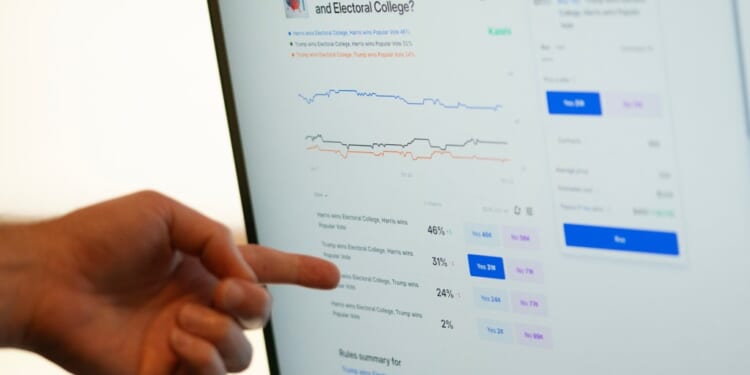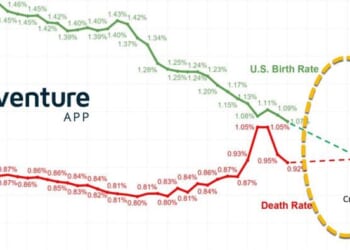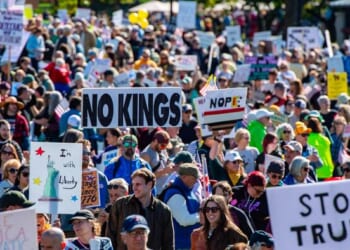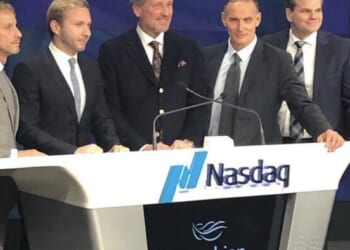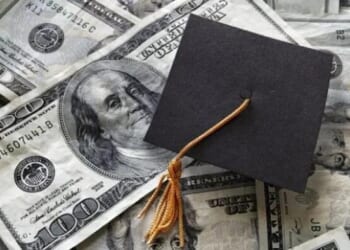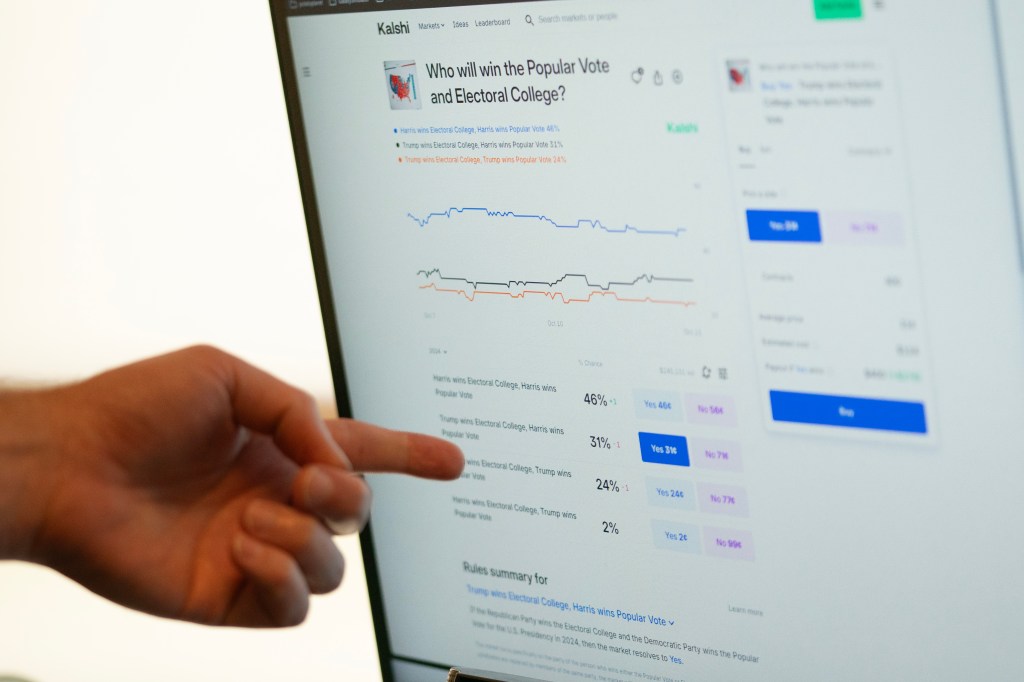
“We had this big change in policy in the last year or so; a combination of the courts and a new administration,” Eric Zitzewitz, a professor of economics at Dartmouth College who studies prediction markets, told TMD. “And now there’s kind of this race going on to see who can get big enough to survive.”
New York-based Polymarket, which has blocked U.S. customers since 2022 following a settlement with the CFTC, secured a $2 billion investment last month from Intercontinental Exchange, the parent company of the New York Stock Exchange, valuing the company at $8 billion. In July, the DOJ and CFTC dropped their investigations into whether Polymarket was still allowing bets from U.S. customers, and the company plans to resume U.S. operations in the coming months.
Kalshi—currently the largest prediction market operating in the U.S.—has similarly secured investments from venture capital firms like Sequoia Capital and Andreessen Horowitz, and has entered into partnership agreements with financial firms like Robinhood and Susquehanna, hitting a $5 billion valuation last month.
But while many economists, statisticians, and election watchers see prediction markets as efficient tools for both forecasting and risk mitigation, praise has not been universal. Critics of the industry worry that it could open the doors to election interference and manipulation, and anti-gambling groups are concerned that the gamification of the political process could contribute to a rise in gambling addictions.
Prediction markets enable users to place bets on the outcomes of various events, ranging from the 2028 Democratic presidential nominee to the removal of Jerome Powell from his position as Federal Reserve chair, and even whether Jesus Christ will return by the end of the year. The “price” of specific outcomes, then, reflects the consensus probability that the event will occur. On the night before the New York City mayoral elections, for example, Kalshi’s market on the race gave Zohran Mamdani a 92 percent chance of victory and around a 25 percent chance of winning by a 24-point margin or greater—only the first of which ended up being correct.
The utility of such predictions, economists and statisticians argue, lies in their relative accuracy compared to traditional polling, lower costs compared to complex forecasting, and their capacity to quickly incorporate new information.
“We have all these institutions and contexts in society where what we try to do is estimate things, and we often do a bad job there,” Robin Hanson, an economist at George Mason University who has helped design internal prediction markets for businesses and government agencies, told TMD. “These mechanisms hold a promise for doing much better in all the other places where estimates matter—in business decisions, in politics, in governance, and in charity.”
Markets act as efficient aggregators of information, allowing individuals to act independently on their personal knowledge, hunches, and biases while synthesizing those judgments into a consensus average. “It’s a bit like the experiments where they have a bunch of jelly beans in a jar and then ask people to guess the number of jelly beans,” Zitzewitz said. “The average of everybody’s guesses turns out to be quite accurate.” The same is true for prediction markets, where market prices are often as accurate as, or more accurate than, traditional polling.
“These markets are, at least in my view, the best forecast we have of what’s going to happen with these elections,” Koleman Strumpf, a professor of economics at Wake Forest University who has studied historical presidential betting markets, told TMD. “They’re not perfect, but they’re pretty good.” Also, Polymarket allows bets based on insider information—and the Nobel Institute is investigating whether this happened with this year’s Peace Prize.
Political prediction markets have already operated in this way in the U.S. for decades, albeit in a more limited form. The Iowa Electronic Markets (IEM)—an online futures market that allows betting on the outcomes of real-world events—has been run by the University of Iowa as a research project on prediction markets since the 1988 election. Since its establishment, the market has often been more accurate than polls at predicting electoral outcomes. “Going back in time, [IEM predictions] are closer to the eventual outcome than polls about 75 percent of the time,” Thomas Rietz, a professor of finance at the University of Iowa who has helped oversee the IEM, told TMD. “When we look at election forecasts, the average forecast error for [IEM] vote fractions is between one and two percentage points, which is typically less than the margin of error in a poll.”
Earlier this year, Rajiv Sethi, a professor of economics at Barnard College, published an academic paper with several of his colleagues evaluating the relative forecasting performance of prediction markets compared to top statistical models during the 2024 election. In their research, Sethi et al. found that, while prediction markets outperformed leading statistical models in high-profile election contests, such as the presidential election and headline Senate and House races, they performed less well in lower-profile contests. “There, you find a much more mixed picture,” Sethi told TMD. Should prediction markets gain increased adoption, however, the accuracy of lower-profile election contests could improve as more bettors participate. “My speculative claim is that as the markets get bigger, they’re going to get more accurate,” Strumpf said.
In cases where having access to okay forecasts quickly is better than having a near-perfect forecast slowly, prediction markets offer significant promise for governments and businesses looking to mitigate risk. During the mid-2000s, Google developed a program known as Prophit that allowed employees to place bets using Goobles—an internal play currency—on questions such as whether a project would be completed on time or how many users might use a new application by the end of the year. Government agencies, including the CIA, have leveraged internal markets to predict the likelihood of various geopolitical events.
Despite the benefits, critics worry that introducing betting markets into American elections risks turning the democratic process into a game, and opens the door to electoral manipulation. Betting on the Carolina Panthers to upset the Green Bay Packers in the NFL is one thing, but allowing Americans to wager real money on who will win elections is, for some, a step too far.
“One of the concerns about prediction markets is that somebody with a lot of money can make huge bets, shift prices, and affect public perceptions,” Sethi said. “With elections, you want to be careful about that, because perceptions can affect actual outcomes. … Market prices can affect behavior, and behavior affects the outcome of the election.” Hanson, however, doesn’t believe it’s fair to criticize only prediction markets for their capacity to influence elections. “That’s not unique to prediction markets, that’s just the generic process of forecasting,” Hanson said. “The world responds to forecasts and often changes its behavior in response to forecasts.”
Election betting has also drawn opposition from some members of Congress. Last year, Democratic Sen. Jeff Merkley of Oregon introduced a bill that would prevent commercialized betting on U.S. elections. “Folks who have the resources to influence the outcome of an election can make a bet and then use their resources to make sure that they come out on the top side of that bet,” Sen. Merkley told TMD. “This isn’t just a thumb on the scale; this is like putting your whole foot on the scale. This is a direct corruption of the whole purpose of elections in our democracy.”
Anti-gambling groups are also rallying against prediction markets. “Predatory gambling is America’s most neglected major problem, and prediction markets have really put a double exclamation point on that now,” Les Bernal, national director of the Stop Predatory Gambling Foundation, told TMD. Activists like Bernal are concerned that the constant exposure to gambling that prediction markets present will put a growing number of Americans at risk of falling prey to predatory gambling organizations. “Not even including these prediction markets, over the next five years, the American people are on course to lose more than $1 trillion of personal wealth to forms of commercialized gambling sanctioned by state governments,” Bernal said. “Anyone can get addicted to this product. It’s about exposure, just like how any one of us can get addicted to cocaine or opioids if we have constant access to it.”
But for better or worse, prediction markets have entered the mainstream—and their influence is unlikely to ever be fully contained again. Kalshi had digital billboards across New York, showing the live odds of the mayoral election.
“We’re never going to go back to a world in which markets are a small part of the forecasting landscape,” Sethi said. “They’re here to stay, regardless of what happens with regard to U.S. policy stance.”

